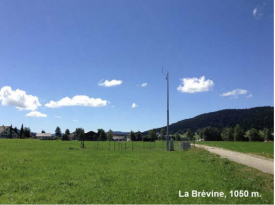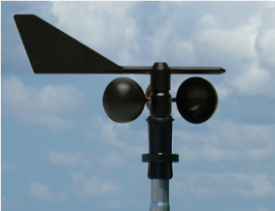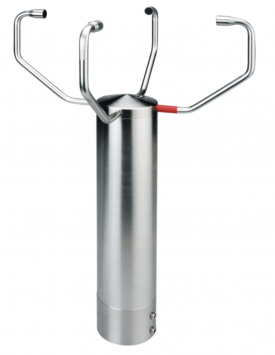What is wind?
In meteorology, wind is a directional bulk movement of air in the Earth's atmosphere. Wind speed and wind direction are measured, which are provided in the following units:
Speed:
- Meter per second (m/s) is the SI unit for speed
- Kilometres per hour (km/h) is the unit of the metric system
- Miles per hour (mph) is the unit used in the US and UK
Direction:
- Degree (°). Decisive for the specification of the wind direction is the direction from which the wind blows. Southerly wind blows from south to north. Since the north is defined as 0°, wind blowing from the south corresponds to a direction of 180°.
How is wind measured?

Figure 1: Weather station in La Brévine Switzerland
Since wind has a mass, it can move objects. This is the property which some of the measuring instruments for wind measurements, e.g.anemometers, take advantage of. The wind speed can thus be determined by the speed of a propeller. Alternatively, other measuring devices measure the wind speed by the reflection or speed of sound or light waves. (see "Which measuring methods exist?" below).
The hourly values of speed are averages from 6 to 10 minute intervals. These intervals consist of 4 measurements per second, which are then aggregated. Maximum and minimum speeds are derived from 3-second intervals consisting of 12 individual measurements.
The direction can be determined for example by a wind vane, which outputs a measured value every second. These are also averaged over 10 minutes and then aggregated to hourly values.
How should an anemometer be set up?
According to the Weather Meteorological Organisation (WMO) standads, an anemometer must be placed on a level surface (optimally cut grass) and 10 meters above the ground. No major obstacles (trees, buildings) affecting the circulation of air must be nearby. The distance from a larger obstacle to the instrument must be at least 4 times the height of the object.
Wind speed and wind direction change with increasing altitude over ground. Therefore meteorological masts usually have wind sensors attached at different altitudes (2m, 10m, 80m, etc.).
Which measuring instruments are used?

Figure 2: Cup anemometer with wind vane
National meteorological services usually employ one of the following two devices to measure wind speed and direction:
- A cup anemometer with wind vane (see Figure 2)
- An ultrasonic anemometer that measures both wind speed and direction (see Figure 3)
Which other measuring methods exist?
A cup or propeller anemometer measures the wind speed using the circular speed of the unit. This includes a wind vane, which measures the direction of the wind. These devices are the most common and often seen on private buildings. Their measurements are relatively accurate, but they have the disadvantage that they can be blocked by dust or by salt at locations near the sea.

Figure 3: Ultrasonic anemometer
Other anemometers (SODAR / LIDAR) do their measurements using the Doppler frequency shift. The so-called Doppler effect works as follows: If the sound / light waves hit a particle in the air that moves towards the instrument, the reflected wave will have a higher frequency than the output signal. With the help of this frequency shift both wind direction and speed can be calculated and thus measured. These measuring instruments have the advantage that they can create a 3D image of the air currents up to 200m in height. This is especially helpful when assessing wind farm locations. However, the instruments only work with limited accuracy when precipitation (rain, snow, etc.) is present, as the waves are reflected by water as well.
The ultrasonic anemometer measures the time that elapses between transmission and reception of the signal between two receptors. If the signal has tailwind, it will arrive faster than the speed of sound, if it has headwind, it will be slower. Since a measuring cycle of this device only takes about 5ms, up to 200 measuring cycles per second can be performed. This makes it possible to measure microcirculations. However this instrument is not reliable to use in precipitation.
For very high wind speeds, there are also pitot pressure anemometers (Pitot tubes). These measure the pressure difference between incoming air and normal pressure.
Difficulties of wind measurement
The biggest problem with wind is that every little object causes turbulence. Even a power line is enough to swirl the wind for a certain distance. Since wind sensors usually need a regular and constant wind to provide accurate measurements, turbulence is not desirable. It is therefore all the more important that the measurement instrument be placed where no obstacles are present.
In the case of propeller or shell anemometers, there is also the problem of contamination or blocking by dust or by salt at locations near the sea. Therefore, they must be serviced at regular intervals. In addition, these devices have a certain delay in heavy gusts of wind, since the shells must first accelerate and the speed of the propeller does not change immediately. The bigger problem is the overspeed after a gust of wind, because of the fact that the devices are created with as little friction as possible (for a fast acceleration), the reduction of the propeller speed is delayed even more with decreasing wind speed.
How many measuring stations are there?
In Switzerland there are 155 official measuring stations operated by MeteoSwiss that measure wind speed and direction. However, this is not enough for a nationwide measuring network representing Switzerland. The Alps pose a major obstacle to wind currents in Switzerland. In addition, there are many small valleys, each representing different microclimatic wind systems.
According to WMO there are about 14,000 weather stations worldwide, which are updated daily. A map of how these weather stations are distributed can be found in the temperature section. The website www.windfinder.com claims to have more than 20,400 stations in its network.


